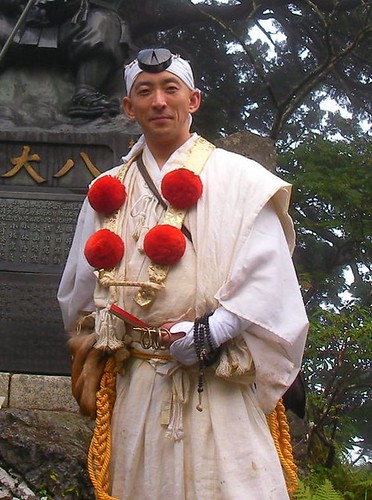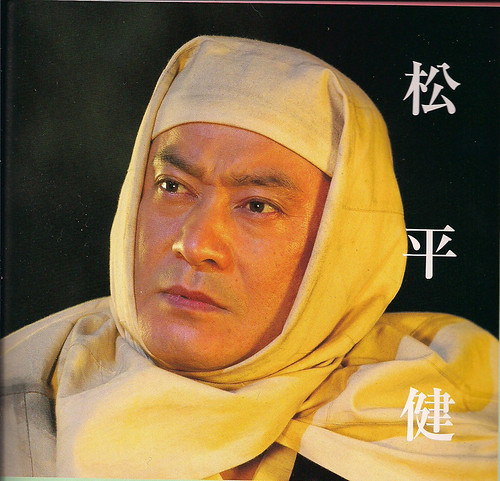Yamabushi and Sōhei Headwear
Nov. 12th, 2016 08:06 pmThis is from the SCA Japanese Facebook community--I was answering a question regarding yamabushi and their headwear. The original question was whether yamabushi would wear the same kind of cowl that sōhei wore into battle, and also if anyone could recommend books/sources on the subject of yamabushi.
[A quick definition: yamabushi 山伏 were/are mountain ascetics, usually solitary monks who adhered to Shugendō, esoteric Buddhism which mostly descends from the Shingon sect, but had other influences as well, including Tendai Buddhism, Shinto, and Daoism. Sōhei 僧兵 were warrior monks that were usually attached to a monastery. Yamabushi would sometimes fight, but they were mostly loners and fought in loose confederations, whereas sōhei were groups attached to monasteries.]
The Teeth and Claws of Buddha by Mikael S. Adolphson is the most thorough book I've found on the subject of warrior monks. Osprey has done two books on them, one on the Yamabushi and one on the monasteries. Interesting general reading, but start with Adolphson's book if you want to go deeper into the subject.
What the sōhei wore on their heads was called kato no kesa 裏頭(か[くわ]とう)の袈裟(けさ), and they were kesa (usually worn on the chest) worn on the head--that is technically what kato no kesa means. The yamabushi would sometimes wear kato no kesa, but the headdress more identified with them is the tokin 頭襟, which looks kinda like a small black box. The Japanese Costume museum has it larger and covering the head, but I've seen pictures of it being smaller and worn near the forehead, as it is today. Here is a site that has some description of yamabushi clothing. It starts with doctrine, scroll down to see the parts about clothing.
As to whether a tokin would be worn in battle, I am not sure. The emaki depictions that I've seen of yamabushi have often just been of them traveling, and they did wear the tokin at those times.
Here's a picture of a yamabushi from the Japanese Costume museum. Note the hat:

from the Japanese Costume Museum
Now compare to this modern Yamabushi--these are the small tokin I've seen in emaki scrolls:
>
from the now-defunct homepage of Kannonji Temple, Shiga Prefecture. Photographer unknown.
And this is an example of the kato no kesa that sōhei wore:

From the Taiga Drama, Yoshitsune, scanned by me.
Update and Correction: when questioned by HE Master Ii Katsumori regarding the modern Yamabushi (who I first identified as a reenactor), I dug deeper to find the origin of the picture, which had been uploaded to Pinterest. The picture is from a now-defunct Japanese webpage (the company hosting it closed, but the Wayback Machine caught it) here: http://homepage3.nifty.com/huayan/temple/event06.htm. I can't link directly to the Wayback Machine's page, but that's the original (defunct) page. Just plug that in the Wayback Machine to see the text (not pictures) of the original.
This used to be the homepage of Kannonji temple. Some more digging showed that the man in the picture is Professor Yoshida Eirie, a professor of Buddhism at Hanazono University in Kyoto and a priest of Kumano Shugendo. Also a martial-arts master of Kukishinden Tenshin Hyoho Ryu. So yes, he IS a modern Yamabushi.
[A quick definition: yamabushi 山伏 were/are mountain ascetics, usually solitary monks who adhered to Shugendō, esoteric Buddhism which mostly descends from the Shingon sect, but had other influences as well, including Tendai Buddhism, Shinto, and Daoism. Sōhei 僧兵 were warrior monks that were usually attached to a monastery. Yamabushi would sometimes fight, but they were mostly loners and fought in loose confederations, whereas sōhei were groups attached to monasteries.]
The Teeth and Claws of Buddha by Mikael S. Adolphson is the most thorough book I've found on the subject of warrior monks. Osprey has done two books on them, one on the Yamabushi and one on the monasteries. Interesting general reading, but start with Adolphson's book if you want to go deeper into the subject.
What the sōhei wore on their heads was called kato no kesa 裏頭(か[くわ]とう)の袈裟(けさ), and they were kesa (usually worn on the chest) worn on the head--that is technically what kato no kesa means. The yamabushi would sometimes wear kato no kesa, but the headdress more identified with them is the tokin 頭襟, which looks kinda like a small black box. The Japanese Costume museum has it larger and covering the head, but I've seen pictures of it being smaller and worn near the forehead, as it is today. Here is a site that has some description of yamabushi clothing. It starts with doctrine, scroll down to see the parts about clothing.
As to whether a tokin would be worn in battle, I am not sure. The emaki depictions that I've seen of yamabushi have often just been of them traveling, and they did wear the tokin at those times.
Here's a picture of a yamabushi from the Japanese Costume museum. Note the hat:

from the Japanese Costume Museum
Now compare to this modern Yamabushi--these are the small tokin I've seen in emaki scrolls:
>

from the now-defunct homepage of Kannonji Temple, Shiga Prefecture. Photographer unknown.
And this is an example of the kato no kesa that sōhei wore:

From the Taiga Drama, Yoshitsune, scanned by me.
Update and Correction: when questioned by HE Master Ii Katsumori regarding the modern Yamabushi (who I first identified as a reenactor), I dug deeper to find the origin of the picture, which had been uploaded to Pinterest. The picture is from a now-defunct Japanese webpage (the company hosting it closed, but the Wayback Machine caught it) here: http://homepage3.nifty.com/huayan/temple/event06.htm. I can't link directly to the Wayback Machine's page, but that's the original (defunct) page. Just plug that in the Wayback Machine to see the text (not pictures) of the original.
This used to be the homepage of Kannonji temple. Some more digging showed that the man in the picture is Professor Yoshida Eirie, a professor of Buddhism at Hanazono University in Kyoto and a priest of Kumano Shugendo. Also a martial-arts master of Kukishinden Tenshin Hyoho Ryu. So yes, he IS a modern Yamabushi.